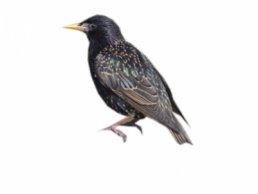
Why Are Starlings in the Garden?
With their mixed diet of fruits, vegetables, seeds, and insects, starlings are right at home in gardens. These birds dig up seeds, eat sprouts, snip buds from stems, and peck at mature fruit. The pests seek out plants at the peak of ripeness, so gardeners coming to harvest their hard-earned crops often find that starlings were there first.
Property owners have the most trouble with starlings in the garden around late summer, when the birds’ diet shifts from insects to plants. During dry periods, damage to fruits and vegetables is usually more severe, as starlings will go after fruit solely for its moisture.
What Does Starling Damage Look Like?
A starling in the garden will eat grapes and small fruit whole but peck holes in larger produce like apples. Apples eaten by starlings are relatively intact outside but hollow inside. Gardeners may see triangular beak marks on the outside of the fruit.
Problems with Starling Control
Starlings feed in large groups, often joining with grackles, cowbirds, and other common pests to create huge flocks. This makes some types of traps ineffective for removing starlings in the garden, as they only catch a few birds at a time.
How to Keep Starlings Out of the Garden
To protect gardens, place bird netting around fruit trees or tall plants. Timing harvests carefully can also be helpful. For example, sunflowers only attract starlings after their seeds are mature, so gardeners should collect the plants immediately to avoid losses. For professional exclusion and removal of starlings in gardens, turn to the wildlife experts at Critter Control.